The Apple Thunderbolt Display Review
by Anand Lal Shimpi on September 23, 2011 2:56 AM EST- Posted in
- Displays
- Mac
- Apple
- Thunderbolt
- Thunderbolt Display
Brightness and Contrast
For brightness, black level, and contrast points, we use the same colorimeter setup described earlier. Specifically, we use an Xrite i1D2 with ColorEyes Display Pro, and take measurements at maximum and minimum brightness of white and black targets. Dynamic contrast is turned off. We also let the panels settle in for a half hour at the respective settings before taking any measurements.
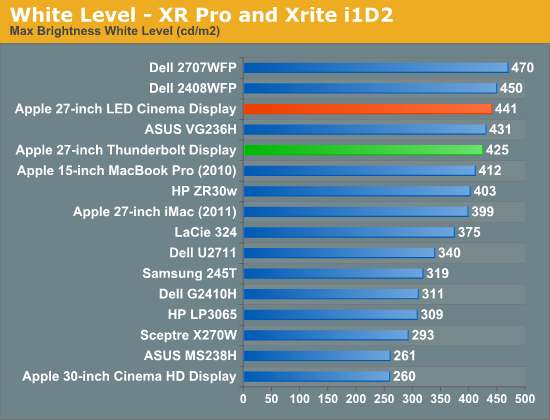
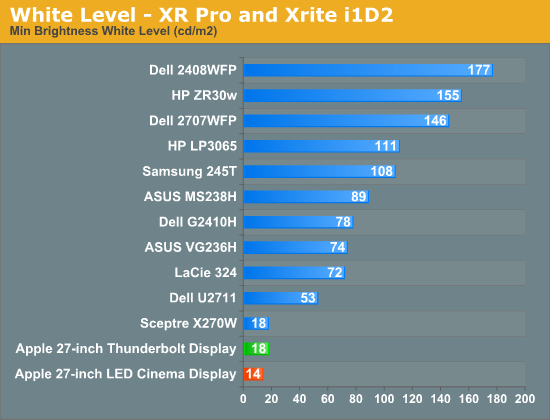
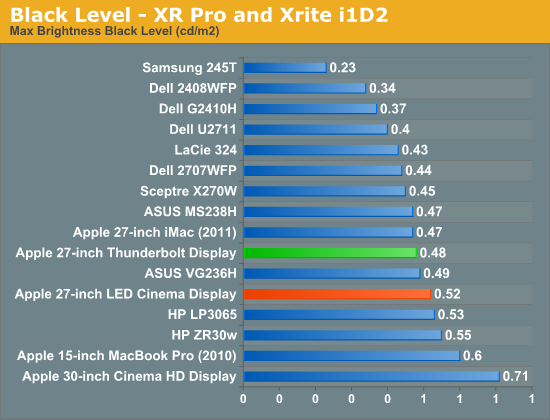
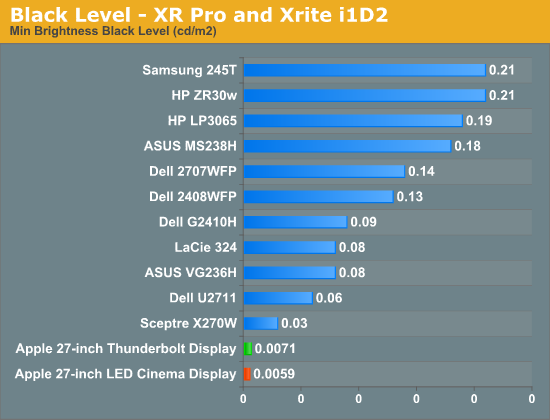
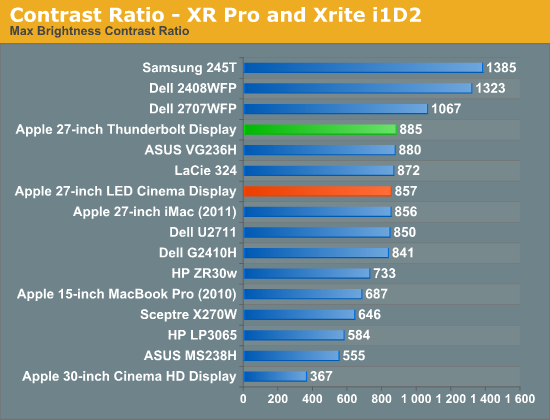
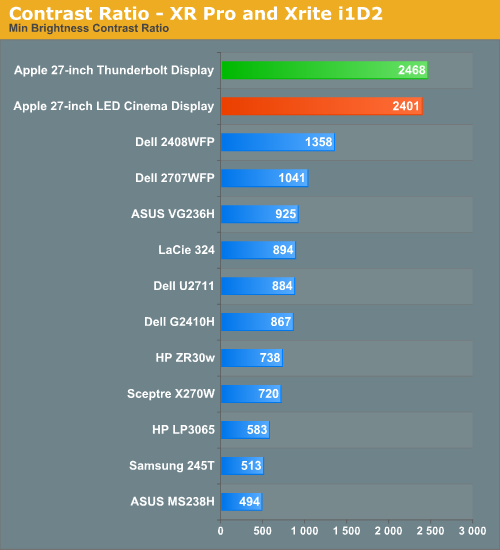
If you were expecting an change in panel quality you won't find it here. The Thunderbolt Display is almost exactly the same as last year's panel but with a bunch of new features.
Brightness Uniformity
In addition to the performance at center, we’ve also added 9-point testing for brightness, both white and black. This is done the same way we measure color uniformity, except we only care about measured intensity. We set the monitor to near 200 nits, and then measure those 9 points.
The Thunderbolt Display performed very well in these tests. The display was very consistent everywhere. Although the center of the panel measured about 8% brighter than the surroundings, it wasn't noticeable in actual use. Brightness uniformity was remarkably consistent through the majority of our measurements, even better than the original 27 we reviewed last year.
White Level Uniformity


Black Level Uniformity

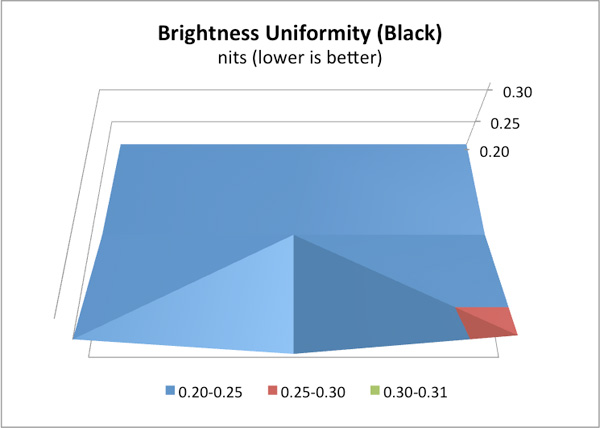
Viewing Angles
The Thunderbolt Display uses an IPS panel which guarantees good horizontal and vertical viewing angles. It doesn't matter how you tilt the display or from what angle you're looking at it (within reason), you'll get a fairly consistent image.















275 Comments
View All Comments
A5 - Friday, September 23, 2011 - link
No shit. Every single review, everywhere, where the hardware is provided by the manufacturer is advertising of some form. This is why you rarely see truly negative reviews of anything.ltcommanderdata - Friday, September 23, 2011 - link
And what monitors are you looking at to get those prices?http://store.apple.com/us/product/MC914?mco=MjQ1Mz...
The Thunderbolt Display is $999 not $1200.
Dell's most comparable device is the U2711 which is IPS and is $1099 regular price, although it's currently on sale for $719.
http://accessories.dell.com/sna/products/Monitors_...
I don't know how frequently Dell does sales, but at regular price the Thunderbolt Display is in fact cheaper than Dell's while including more dock features like ethernet, firewire, speakers, etc.
Stas - Friday, September 23, 2011 - link
Do a google search on the model and you will find at least 5 online sellers that have the Dell monitor for <$850Constructor - Friday, September 23, 2011 - link
Sure. The Dell doesn't have an LED backlight, however, so apparently they're selling off the old stock with CCFL backlights before moving on to LED as well.It's tougher to get a larger colour space with a (white) LED backlight, but on the other hand it's mercury-free, uses significantly less power and lives longer than CCFL.
doubledeej - Sunday, September 25, 2011 - link
CCFL backlit monitors still have a better image. That's why you find them on the high-end monitors from other manufacturers. Apple is sacrificing quality by moving to LED. Look at the charts in the article. The Thunderbolt and Cinema Display monitors both fall in the bottom third of nearly all of them. They aren't that great. LED gives better power usage, but it comes at a price in terms of image quality.Constructor - Sunday, September 25, 2011 - link
Better power efficiency, better longevity, zero mercury.Quite significant advantages.
And in most metrics the TBD is actually pretty decent, particularly for its resolution and price.
CCFL makes it cheaper to get a larger colour space than with RGB LEDs again at the very top.
But for that it's far dirtier in all three dimensions (wastes power, turns the display into e-waste a lot sooner and releases mercury if not dismantled very, very carefully – and even then the mercury remains hazardous waste).
Very few people actually have a use for an expanded colour space. Still few people actually experience limitations with brightness uniformity (my iMac 27" is fully sufficient for all my uses, with no problem noticeable). And all people benefit from the advantages.
It would have been silly for Apple to make a display that's specialized to only very few people's needs and saddling everyone with lots of disadvantages. Eizo can do that. They've got many models and they are largely specializing on these kinds of uses (and even they are on their way towards LED backlights).
jecs - Friday, September 23, 2011 - link
He went to the Apple store and confused the starting iMac to the Thunderbolt display. Some are so eager trying to look calm and cool but forget to check the facts.And you started saying "Nice but..."
Nice to what? if you did not check the real price you are objecting
Are you going to say now that you like the Apple display?
TypeS - Friday, September 23, 2011 - link
Better check the price again there bud, it's $990.00USDhttp://store.apple.com/us/product/MC914LL/A?fnode=...
The Macbook Air also starts at $990.00USD as well:
http://store.apple.com/us/browse/home/shop_mac/fam...
That's a grand total of $1980 before taxes
The 13" Pros starts at $1199 as well.
Dell lists it's U2711 at $1099 retail, with a current sale price of $949.
If we take your assumption that ASUS/Samsung have similar spec'd and functional alternatives or $900, the total savings is $150.That is a far cry from half.
Anti-apple critics are just as bad as the brainwashed Apple fanboys when they start pulling facts out of thin air.
cactusdog - Saturday, September 24, 2011 - link
The prices I quoted are from the Apple website in my country and they are accurate. Apple charge us a lot more than they do in the US.You're choosing the cheapest/smallest macbook that nobody wants and saying they are cheap. They are not. You can get a similar speced notebook for much less from Asus.
mcnabney - Friday, September 23, 2011 - link
Didn't you read the review? This display has poor color accuracy so you really can't compare it to displays that have it. Anand indicated that people accustom to laptop displays wouldn't notice it, but I guarantee that people who have historically bought and needed high quality displays WILL notice it. So you can't really compare Apple's new display to competitors that make displays for the publishing/imaging business.